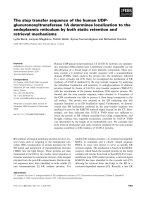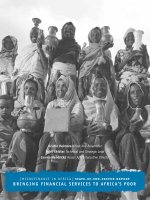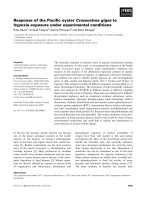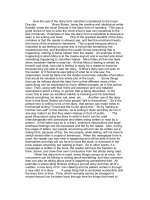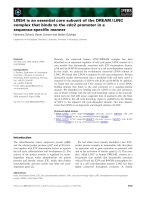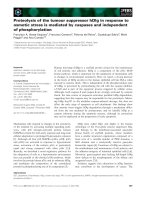Confronting crimes of the past timor leste after 1999 to punish or forgive
Bạn đang xem bản rút gọn của tài liệu. Xem và tải ngay bản đầy đủ của tài liệu tại đây (1001.13 KB, 203 trang )
SUMMARY...................................................................................................................................... 3
I.INTRODUCTION......................................................................................................................... 4
II.TIMOR LESTE: A NATION’S QUIET UNRELENTING STRUGGLE FOR
INDEPENDENCE ......................................................................................................................................... 8
A.PRE-COLONIZATION AND THE ARRIVAL OF THE PORTUGUESE ..................................................................9
B.THE UNFULFILLED PROMISE OF INDEPENDENCE: INDONESIA’S INVASION OF EAST TIMOR.......................... 10
C.TEARS AND TRIUMPH: TIMOR’S JOURNEY TOWARDS INDEPENDENCE..................................................... 13
D.THE UN’S ADMINISTRATION OF EAST TIMOR................................................................................... 15
III.MODELS OF POST-CONFLICT JUSTICE.........................................................................16
A.CRIMINAL JUSTICE........................................................................................................................20
1.The retributive purposes of criminal justice....................................................................... 21
2.The utilitarian purposes of criminal justice........................................................................ 22
3.International criminal justice and its objectives................................................................. 24
B.RECONCILIATORY JUSTICE..............................................................................................................25
1.Reconciliation: an unsettled notion.................................................................................... 25
2.Reconciliation: aiming to heal all those directly affected.................................................. 27
3.Reconciliatory justice as applied and defined in State practice......................................... 28
C.COMPARING CRIMINAL AND RECONCILIATORY JUSTICE.........................................................................30
1.Never shall the twain meet ................................................................................................. 30
2.As trade offs: Reconciliatory and criminal justice as mutually exclusive...........................34
3.As supporting and separate: reconciliatory and criminal justice working hand-in-hand..37
IV.WHAT DOES INTERNATIONAL LAW SAY? SEARCHING FOR AN
INTERNATIONAL OBLIGATION TO PROSECUTE INTERNATIONLA CRIMINALS................39
A.DISTILLING POSITIVE STATEMENTS OF AN INTERNATIONAL OBLIGATION TO PROSECUTE INTERNATIONAL CRIMES.
40
1.Clarifying the debate: Primary and secondary Norms at international law...................... 40
2.Considering the hierarchy of international legal obligations in searching for a mandatory
obligation..............................................................................................................................................41
3.Drawing the link between Jus Cogens norms and Erga Omnes obligations...................... 44
B.THE SEARCH FOR AN ERGA OMNES OBLIGATION TO PROSECUTE INTERNATIONAL CRIMES ......................... 45
1.Examining Treaty law ....................................................................................................... 45
2.Examining State Practice.................................................................................................... 46
3.Examining soft law sources.................................................................................................49
C.CONSIDERING THE EMERGING TREND IN RECONCILIATORY JUSTICE....................................................... 51
1.The rise of the truth and reconciliation commission...........................................................51
2.Trends of reconciliatory justice in times of peace ..............................................................54
V.TIMOR LESTE’S POST CONFLICT JUSTICE SYSTEM.................................................. 60
A.THE SERIOUS CRIMES PANELS....................................................................................................... 60
B.THE COMMISSION FOR RECEPTION TRUTH AND RECONCILIATION ........................................................64
C.EXAMINING THE INTERACTION BETWEEN THE SERIOUS CRIMES PANELS AND THE RECONCILIATION
COMMISSION..................................................................................................................................................71
VI.ASSESSING POST-CONFLICT JUSTICE OBJECTIVES.................................................74
A.ASSESSING THE GOALS OF CRIMINAL JUSTICE AS PERCEIVED THROUGH TIMORESE EYES........................... 74
1.Timor’s post-conflict justice: Addressing high-level responsibility....................................76
2.The Serious Crimes Panels attempts at addressing the militia phenomenon..................... 88
1
B.TIMOR LESTE’S RECONCILIATION COMMISSION: ACHIEVING THE GOALS OF RECONCILIATORY JUSTICE....... 94
1.The Reconciliation Commission’s reconciliation of wrongdoers and victims....................95
2.The Reconciliation Commission’s reintegration of wrongdoers into communities.......... 100
VII.THE TIMORESE RESPONSE TO A DUAL-TRACK POST-CONFLICT JUSTICE
SYSTEM......................................................................................................................................................105
A.UNDERSTANDING THE TIMORESE PERCEPTION OF JUSTICE ................................................................ 105
1.Timor’s historical and political legacy............................................................................. 106
2.Examining the dual-track culture of justice in Timorese society...................................... 108
3.Lessons from Timor: rethinking the boundaries of criminal punishment......................... 110
VIII.OWNERSHIP OF POST-CONFLICT JUSTICE: WHO DECIDES?........................... 113
A.ADDRESSING POPULAR MISCONCEPTIONS OF NON-WESTERN DISPUTE RESOLUTION MECHANISMS...............114
1.Perceived informality in non-Western dispute resolution systems: the imposition of
Western notions of formality...............................................................................................................115
2.Non-Western dispute resolution mechanisms’ inadequate protections: Do international
human rights standards provide the only effective framework of protection?................................... 117
B.ANSWERING THE QUESTION OF POST-CONFLICT JUSTICE OWNERSHIP ....................................................122
1.Balancing international and domestic needs : the UN as mediator................................. 124
2.Post-conflict justice in Timor: examining the decision-making process.......................... 131
IX.CONCLUSION....................................................................................................................... 137
X.BIBLIOGRAPHY.................................................................................................................... 140
APPENDIX I.................................................................................................................................148
APPENDIX 2................................................................................................................................ 153
APPENDIX 3................................................................................................................................ 158
APPENDIX 4................................................................................................................................ 165
APPENDIX 5................................................................................................................................ 177
APPENDIX 6................................................................................................................................ 182
APPENDIX 7................................................................................................................................ 189
APPENDIX 8................................................................................................................................ 195
APPENDIX 9................................................................................................................................ 198
APPENDIX 10.............................................................................................................................. 201
2
FORGIVENESS AND PUNISHMENT IN POST-CONFLICT TIMOR
SUMMARY
This thesis explores the post-conflict justice system of Timor Leste, formerly
known as East Timor. In 1999, after 25 years of Indonesian occupation, Timorese finally
exercised their right to self-determination in an UN-administered referendum. Upon
announcement of the referendum’s results, the tiny island erupted in orchestrated
massacres, forced deportations and “scorched earth operations” aimed at punishing the
Timorese for their vote. Today, Timor Leste’s post-conflict institutions, consisting of the
Serious Crimes Panel and the Commission for Reception, Truth and Reconciliation, set
up a unique two-track justice system that simultaneously delivers both criminal justice
and reconciliatory justice for crimes committed during Indonesia’s occupation. Informed
by the author’s experiences as a legal intern with the Serious Crimes Panel and interviews
conducted by the author with personnel at the Serious Crimes Panel, the Commission and
ordinary Timorese, this thesis examines the rationale underlying Timor Leste’s unique
two-track justice system, in particular its “serious” and “non-serious” subject matter
division. It examines why criminal justice for “serious” international crimes was insisted
upon by the UN despite the preference of local Timorese politicians for all crimes to be
dealt with by the Commission, a decision which in effect resulted in Timor Leste’s twotrack system. In doing so, this thesis examines how this two-track justice system has
functioned and whether it has achieved goals envisioned by the UN or Timorese. It
addresses the larger question underlying all these issues, of whether decisions on postconflict justice should lie with the post-conflict society itself or the international
community.
3
I.INTRODUCTION
The year 1999 will forever be indelibly seared in Timorese history. It was the year in
which, after centuries of colonization by the Portuguese and another 25 years of
occupation by Indonesia, that each and every Timorese were to vote if they wished, for
their nation’s independence. It was the year in which all Timorese lived in constant fear
as Indonesian forces mounted campaigns of intimidation against pro-independence
supporters. It was the year that saw East Timor voting for its independence, a vote which
led to the small territory being engulfed by a violence unparalleled in the nation’s already
sad history as pro-Indonesian militia groups swept through Timorese towns and villages
exacting revenge for the Timorese population’s “betrayal” of Indonesia. 1999 witnessed
indiscriminate massacres and “scorched earth” operations that resulted in the death of
hundreds of Timorese and the destruction of 75% of Timor’s infrastructure. Today, East
Timor has a new constitution, a newly elected government and parliament. But, memories
of 1999 and Timor’s violent past still remain-as can be seen in the occasional charred
building, newly erected memorials and ongoing post-conflict justice processes set up to
address crimes committed in 1999.
Unlike other countries emerging from civil conflict, Timor Leste, as East Timor came
to be called, made post-conflict justice one of its priorities. The United Nations, which
had organized the 1999 referendum in Timor, set up the United Nations Transitional
Administration in East Timor (UNTAET) which was charged to exercise executive and
legislative powers over Timor Leste while preparing the territory towards full
independence.1
On 6 June, 2000, UNTAET established the Serious Crimes Panels
(hereinafter known as the Serious Crimes Panels) and the Department of Prosecution of
Serious Crimes, (hereinafter known as the Serious Crimes Unit criminally prosecute
“serious crimes” particularly those committed in 1999.2 Not long after, UNTAET
responded to Timorese leaders’ calls for reconciliatory justice by designing in
collaboration with wide segments of Timorese community the Commission for
Reception, Truth and Reconciliation (hereinafter known as the Reconciliation
Commission).3 The Commission was set up on 13 July 2001 with jurisdiction over cases
not falling within the exclusive jurisdiction of the Serious Crimes Panels. 4
This thesis outlines the historical events and circumstances that led to the
establishment of Timor Leste’s Serious Crimes Panels and Her Reconciliation
Commission. It analyzes how these two institutions have de facto established a two-track
post-conflict justice system in which international crimes are subject to a formal criminal
justice system heard before the Serious Crimes Panels while non-international crimes
undergo reconciliation before the Reconciliation Commission. In particular this thesis
1
S.C. Res. 1272, U.N.SCOR, 4057th meeting, U.N. Doc. S/RES/1272 (1999)
UNTAET Regulation 2000-11 (On the Organization of Courts in East Timor) set up the Timorese judicial
system and states the Dili District Court’s exclusive jurisdiction over “serious crimes”, Reg. No. 2000-11,
UNTAET, 6 March 2000, UNTAET/REG/2000/11, s10; UNTAET Regulation 2000-15 (On the
Establishment of Panels with Exclusive Jurisdiction over Serious Crimes) focuses on detailing the subject
matter jurisdiction of the Dili District Court, Reg. No. 2000-15, UNTAET, 6 June 2000,
UNTAET/REG/2000/15; UNTAET Regulation 2000-16 (On the Organization of the Public Prosecutor
Service in East Timor) establishes the Public Prosecutor’s Office within which the Deputy General
Prosecutor for Serious Crimes is charged with setting up a Prosecution Unit responsible for the prosecution
of Serious Crimes as defined in Reg. No. 2000-11 and Reg. No. 2000-15, Reg. No. 2000-16, UNTAET, 6
June 2000, UNTAET/REG/2000/16, s.14
3
Reg. No. 2001-10, UNTAET, 13 July 2001, UNTAET/REG/2001/10, more popularly known as by its
Portuguese acronym the CAVR which stands for “Comissao de Acolhimento, Verdade e Reconciliaocao de
Timor-Leste
4
Note that Reg. No. 2001-10 states that “In no circumstances shall a serious criminal offence” be dealt with
by the CAVR, Reg. No. 2001-15 supra. n2 at s. This was amended by Reg. No. 2002-9 to state that “in
principle, serious criminal offences” shall not be addressed by the CAVR , Reg. No. 2002-9, UNTAET, 18
May 2002, UNTAET/DIR/2002/09
2
examines why the UN insisted that international crimes be criminally prosecuted despite
Timorese indigenous traditions of reconciliatory justice and the expressed preference of
Her local politicians for reconciliation rather than criminal prosecution. In doing so, this
thesis will first and foremost consider if Timor Leste is obligated under international law
to criminally prosecute crimes committed during conflict, including those categorized as
international crimes. Based on current State and international practice, this thesis
concludes that such an international obligation has yet to clearly crystallize. After
concluding such, that Timor Leste’s post-conflict justice is rooted not in the observance
of international obligations, this thesis goes on to examine the rationale behind Timor
Leste’s preference for criminal justice over reconciliatory justice when dealing with
“serious” international crimes. It examines the objectives of criminal and reconciliatory
justice from Timorese society’s perspective and assesses if the Serious Crimes Panels and
the Reconciliation Commission have fulfilled these said objectives. It also attempts to
debunk preconceived notions on non-Western alternative dispute resolution methods
which have arguably contributed to the preference of Western forms of criminal justice
over indigenous forms of dispute resolution. Lastly it addresses the larger underlying
question of post-conflict justice ownership and suggests how a possible balance between
international and national interests can be achieved by the UN.
The writer of this thesis was in Timor Leste from December 2003 to January 2004,
attached to the Serious Crimes Unit and had the opportunity of speaking to various UN
prosecutors, Commissioners from the Reconciliation Commission, grass-root community
leaders and local non-governmental organization workers on the operation and practice
of the two-track justice model. This thesis will attempt to reflect views and concerns of
the Timorese people relating to the impact of the two-track justice model on their lives.
II.TIMOR LESTE: A NATION’S QUIET UNRELENTING STRUGGLE FOR
INDEPENDENCE
The island of Timor lies at the very tip of the Indonesian archipelago, about 600 km
from Darwin, Australia. Timor Leste or East Timor as it was called when under
Indonesian occupation, is made up of the eastern half of Timor island, the Oecussi
enclave within West Timor and the two islands of Atauro and Jaco.5 Despite Timor’s
geographical proximity with Indonesia, the Timorese differ from Malay Indonesians in
terms of their ethnic origins, and social and cultural background.6 Timorese society
remained relatively isolated from Javanese culture, the dominant Indonesian culture, up
till Indonesia’s 1975 invasion. Unlike the rest of present-day Indonesia which was
brought under the unifying and dominating influence of Java and Sumatra’s ancient
kingdoms such as the Majapahit empire, Timor’s scattered kingdoms flourished and
developed independent from external influences aside from occasional trading
agreements by individual Timorese kings with non-Timorese traders.
This chapter briefly describes Timor Leste’s political history prior to its
independence.
5
For general overviews on Timor’s history, see JOHN G.TAYLOR, EAST TIMOR: THE PRICE OF FREEDOM (Zed
Books: London, 1999); East Timor : Historical Background, Focus International, published by UK Foreign
and Commonwealth Office, London, October, 1999; OUT OF THE ASHES: DESTRUCTION AND RECONSTRUCTION OF
EAST TIMOR (James J.Fox & Dionisio Babo Soares eds., Crawford House Publishing: Adelaide, 2000)
6
When around 2500 BC the Proto-Malays, descendents of todays Indonesians pushed into western
Indonesia settling down in Java, coastal Sumatra and Borneo. They did not reach Timor.
A. Pre-colonization and the arrival of the Portuguese
In 1515, Portuguese traders arrived on the island of Timor with Dutch trading ships in
hot pursuit. Both were attracted by Timor’s reserves of sandalwood and spices. 7 Over the
next 300 years, the Dutch and Portuguese squabbled over ownership of Timor island. The
respective claims were finally settled in 1913 before the Permanent Court of Arbitration
which divided Timor between the two colonial powers. Portugal was awarded the eastern
part of Timor island or East Timor. What is of interest is that despite Portugal and
Holland’s claims of ownership over Timor, neither of these colonial powers asserted
effective control over Timor island. Indigenous structures proved extraordinarily resistant
to both colonial powers, due to tightly-knit kinship ties between Timorese families and
clans.
At the end of the 19th century the Portuguese finally took concrete steps to establish
effective control over East Timor. So as to specifically undermine indigenous power
structures, Portugal put in place administrative units which conflicted with indigenous
lines of influence. This strategy failed as formal administrators installed by the
Portuguese found that they needed the support of local political leaders in order to be
effective and therefore sought approval from local political leaders.8 Formal colonial
structures thus co-existed with indigenous political structures. Aside from other attempts
to establish effective control over the local population politically or culturally, East
7
James J. Fox, Tracing the Path, Reconstructing the Past, in , OUT OF THE ASHES supra note 5 at 16. Fox
records that both the Dutch and Portuguese had to hold regular armed expeditions into Timor to subdue the
Timorese. Between 1847 and 1913 the Portuguese mounted no less than 60 armed expeditions into East
Timor.
8
TAYLOR, supra note 5 at 12, Taylor points out that while colonial authority was sanctioned through
coercion and the use of force, traditional authority continued due to the power of cultural tradition.
Timor, as Portugal’s most far-flung colony was largely neglected by her colonial master.
In 1973 about 93% of East Timor’s population remained illiterate.9
B. The unfulfilled promise of independence: Indonesia’s invasion of East Timor
In 1974 Portugal’s colonization of East Timor came to an end when regime
change in Portugal resulted in changes in Portugal’s colonization policy. Tired of
administering far-flung colonies such as East Timor, Portugal’s new government
committed itself to Timor’s decolonization. In October 1976, Portugal set up a
transitional government in East Timor to organize local elections in East Timor. Before
these elections could be carried out, suspicion and disagreement over Timor’s future
political status caused frictions between two of East Timor’s most prominent local
political parties, the Front for the Liberation of Timor (Fretilin) and the United
Democratic Timor (UDT). Both factions resorted to arms and civil conflict broke out in
East Timor. On 4 December 1974 Indonesia invaded East Timor with the ostensible
reason of preventing the escalation of East Timor’s civil conflict and any possible spill
over effects on Indonesian territory.
10
Following this invasion, on 31 May 1975,
Indonesia organized the signing of an Act of Integration which called for East Timor’s
integration with Indonesia. This Act was signed by 28 supposedly elected Timorese
representatives. In reality only 5 of these 28 members were elected.11
9
For an overview of Portuguese rule see TAYLOR, id at 16-19
TAYLOR, id at 20
11
Lord Averbury, A Positive Legal Duty: The Liberation of the People of East Timor, in SELFDETERMINATION: INTERNATIONAL PERSPECTIVES, (eds. Donald Clark & Roger Williams, 1996), p 217
10
0
Overpowered by Indonesia’s superior military strength, East Timorese actively
resisting and opposing Indonesia’s invasion were forced underground. Most were from
the local political party Fretilin who organized themselves into Falintil, an armed
resistance wing of Fretilin. Over the following years, the Indonesian army sought to root
out and suppress local East Timorese dissent. From time to time, the Indonesian military
would conduct campaigns of “encirclement and annihilation”, aimed at the “surrounding
of the population in an area, followed by their transportation to newly-created strategic
camps and the killing of Fretilin members and sympathizers”.12 During armed expeditions
into Timor’s forested interior, the Indonesian army would forcibly recruit ordinary
villagers for what came to be known as “fence of legs” operations in which hundreds of
local villagers would be lined up as “fence of legs” or human targets in front of the
Indonesian military during their incursions into Fretilin territory. The largest recorded
number of civilians involved in a single such “fence of legs” operation was about 80 000
male villagers.13 The Indonesian military also uprooted and resettled the local population
in “resettlement villages” which were put under armed guard so as to prevent the villagers
from aiding rebel fighters.14 All in all, a comparison of Portuguese census figures and
Indonesian census figures demonstrate that Indonesian occupation of East Timor resulted
in 100 000 deaths, the deaths of one third of Timor’s local population.15
Apart from actively suppressing local resistance, the Indonesian authorities also
attempted to replace Timorese culture with dominant Indonesian Javanese culture which
12
TAYLOR, supra note 5 at p 85
Id at 117
14
Id at 123
15
East Timor : Historical Background, Focus International, published by UK Foreign and Commonwealth
Office, London, October, 1999, supra note 5 at p4
13
1
sought to erase the Timorese population’s self-consciousness as a nation. The authorities
implemented socialization programs in Timorese schools and set in place transmigration
programs involving the migration of Indonesians from other parts of Indonesia into
Timor.16
All throughout Indonesia’s colonization, the Indonesian authorities faced
continued resistance from Fretilin and its armed wing Falintil. Much of Fretilin’s efforts
were aimed at mobilizing the masses and cultivating the continued support of local
traditional leaders.17 Campaigns were also launched abroad in an attempt to alert the
international community to East Timor’s plight. The international community however
remained largely paralyzed by inaction. Apart from various UN Security Council
Resolutions
18
and UN General Assembly Resolutions19 calling for Indonesia’s
withdrawal from East Timor, most influential States were reluctant to offend Indonesia
which was perceived by these States as an important strategic partner in the South-east
Asian region.20 Political records which have surfaced in recent years reveal the complicity
or at least acquiescence of States such as America and Australia in Indonesia’s plan of
annexing East Timor. 21
16
TAYLOR, supra note 5 at 124-128
Fernando de Araujo, The CNRT Campaign for Independence in OUT OF THE ASHES supra note 5 at 108-110
this same approach was adopted by CNRT during the campaign for independence post-referendum
announcement. The youth were tasked to go from door-to-door explaining independence to the villagers.
18
S.C. Res. 384, 30 U.N. SCOR, U.N. Doc S/Res/384 (1975)
19
G.A. Res. 3485, 30 U.N. GAOR, U.N. Doc. A/Res/3485 (1975) (72 in favour, 10 against, 43
abstentions); G.A. Res. 31/53, 31 U.N. GAOR, U.N. Doc. A/31/362 (1976) (68 in favour, 20 against, with
49 abstentions); G.A. Res. 32/24. 32 U.N. GAOR, U.N. Doc. A/32/357 (1977)(67 in favour to 26 against,
with 47 abstentions); G.A. Res. 37/30, 37 U.N. GAOR, U.N. Doc A/37/51 (1982) (50 in favour of, 46
against, with 50 abstentions); see also G.A. Res. 33/39; 33 U.N. GAOR, U.N. Doc. A/33/455 (1978); G.A.
Res 34/40, 34 U.N. GAOR, U.N. Doc. A/34/46 (1979); G.A. Res. 35/27, 35 U.N. GAOR, U.N. Doc.
A/35/48 (1980); G.A. Res. 36/50, 36 U.N GAOR, U.N. Doc. A/36/51 (1981)
20
Jani Purnawanty, Various Perspectives in Understanding the East Timor Crisis, 14 Temp. Int'l & Comp.
L.J. 61, 63 (2000) at 65
21
Jessica Howard, Invoking State Responsibility for Aiding the Commission of International CrimesAustralia, the United States and the Question of East Timor, Melbourne Journal of International Law (Vol
17
2
C. Tears and Triumph: Timor’s journey towards independence
In 1998, the East Timorese cause was once again taken up by the international
community as popular revolution led to change in political leadership in Indonesia.22 On
27 January 1999 Indonesian President Habibie responded to international pressure and
announced that Indonesia would hold a referendum in East Timor giving every Timorese
the opportunity to vote for autonomy or outright independence.23 Habibie’s decision went
against the interest of many Indonesian military leaders who had important economic and
political stakes in East Timor. These military leaders reacted to Habibie’s announcement
by organizing Operasi Sapu Jagad. The aim of this operation was to portray East Timor
as racked by civil conflict and unprepared for any form of self-government.24 Paramilitary
groups which were supported, trained and financed by the Indonesian army were charged
with intimidating and terrorizing the local Timorese population. 25
While such orchestrated campaigns of intimidation being were carried out,
Indonesia’s political leaders were engaged in negotiations with the UN and Portugal.
Portugal, the former colonizing power of Timor, represented Timorese interests at these
2) at 2
22
Fernando de Araujo, The CNRT Campaign for Independence in OUT OF THE ASHES supra note 5 at 106
23
Id , Araojo notes that Habibie was in part willing to hold the referendum as he had “received false reports
from the military claiming that they were in complete control and that they had already done everything they
could to convince the people that the best choice for the future of East Timor was the autonomy option”.
24
Countering the argument that East Timor has had an endemic culture of violence, in his statement to the
observes “it is a classic example of how low intensity warfare and counter-insurgency techniques the
Kopassus…had been trained to operate in communities to create a climate of terror, hysteria and violence…
The violence is meant to create a situation ultimately where it is necessary then to step in to restore order…
So I would argue as to whether in fact you are talking about culture and human behaviour, that we are
talking about a culture where there was, prior to the presence of these militias, a culture of violence. I do not
thinkt hat necessarily has been the case-I thinkit has been fostered. I think it has been nurtured”
25
TAYLOR supra note 5 at xix-xii
3
negotiations due to Indonesia’s reluctance to officially recognize and negotiate with
Timorese resistance leaders. On May 5, 1999 Indonesia and Portugal, the latter
representing Timorese interests, finally agreed on the modalities of the referendum to be
held in East Timor. According to the security agreements, which came to be known as the
May 5 Agreements, the United Nations Assistance Mission in East Timor (UNAMET)
would be responsible for the organization and administration of the referendum while
Indonesian police forces would be charged with maintaining security during the
referendum.26 On 4 June 1999 UNAMET commenced operations in East Timor.
However, due to paramilitary activities and violence UNAMET was forced to twice
postpone the referendum. On 30 August 1999, the referendum was eventually conducted.
Despite paramilitary activity and intimidation, more than 90% of Timorese turned up to
cast their votes. 78% chose independence. Upon UNAMET’s announcement of the
referendum’s results, East Timor erupted into violence as the Indonesian military, police
and army-backed militia carried out massacres of civilians and “scorched earth
operations”. Within two weeks, the violence had caused some 330 000 Timorese to seek
refuge in the jungles of Timor’s mountains while another 150 000 were forcibly deported
by the Indonesian military into concentration camps set up in West Timor.27 On 10
September 1999 UNAMET itself was forced to leave as its staff and compounds came
under attack by paramilitary groups.28
26
Question of East Timor: Report of the Secretary General, U.N. GAOR, 53rd Sess., U.N. Doc. A/53/591
(1999), Annex I, 1 [hereinafter known as the May 5 Agreements]
27
TAYLOR, supra note 5 at xii; In August 1999 a document was found in the Dili police department
regarding “Operasi Remember Lorosae II” a plan for mass evacuation of Timorese to West Timor in the
event independence was voted for, also found was an order dated 5 May 1999 cabled from General
Subagyo Hadi Siswoyo, TNI Chief of Staff to Colonel Tono Suratman, commanding officer in Dili ordering
him to “prepare a security plan to prevent civil war that includes preventative action policing measures,
repressive/ coercive measures and a plan to move to the rear/ evacuate if the second option (of
independence) is chosen”, both of which are referred to in Australian Parliamentary Report, Chapter 4. 5.50
28
Id at xxvi-xxvii
4
D. The UN’s administration of East Timor
As the violence in East Timor escalated, the UN Security Council sent a delegation to
Jakarta on 7 September 1999 to meet with the Indonesian government.29 On 12
September 1999, President Habibie was finally persuaded to agree to a UN peacekeeping
force in East Timor.30 On 21 September 1999 the International Force for East Timor
(INTERFET), an Australian-led peacekeeping force of 8000 landed in Dili.31 On 25
October 1999, the UN Security Council established the United Nations Transitional
Administration of East Timor (UNTAET) which would be responsible for the interim
governance of East Timor and the territory’s transition to full independence.32
UNTAET was also charged with seeking accountability and justice for the 50006000 deaths which occurred in 1999.33 To do this, UNTAET would have to choose
between the various post-conflict justice models already existing in State practice. The
next section will analyze the different models of post-conflict justice currently existing in
State practice and their underlying jurisprudential principles.
29
Indonesia responded by declaring martial law, transferring control from the police under the May 5
agreement back to the military Id at xxx-xxxi
30
Id at xxx-xxxi
31
S.C. Res. 1264, U.N. SCOR, 54th Sess., 4045th mtg., U.N. Doc. S/RES/1264 (1999) which authorized the
creation of a multinational force for East Timor
32
S.C. Res. 1272, supra note 1; following the granting of East Timor’s independence on May 20, 2002, the
United Nations Mission of Support in East Timor (UNMISET) assumed UNTAET’s mandate for
prosecuting serious crimes and assisting the judicial sector, see S.C. Res. 410, U.N. SCOR,57th Sess.m,
4534th meg., U.N. Doc. S/RES/1410 (2002)
33
TAYLOR, supra note 8 at xxiv
5
III.MODELS OF POST-CONFLICT JUSTICE
Throughout East Timor’s 1999 conflict, the UN Security Council and General
Assembly had consistently maintained that perpetrators of international crimes would be
“brought to justice”. Modern history is replete with instances of political upheaval during
which atrocities are committed as opposing groups struggle for political power. The
magnitude of such atrocities is exacerbated by the general breakdown in law and order.
Successor governments emerging from such civil conflicts more often than not avoid or
refuse to address crimes committed during periods of political transition for a myriad of
reasons ranging from the new government’s lack of resources, the country’s continuing
political instability or the need to focus on the citizenry’s more pressing survival needs.
Nevertheless successor States or governments increasingly find themselves facing
demands by international actors whether States, organizations or civil society, to address
crimes committed during times of transition. These demands are part of a larger
phenomenon that is changing the international legal landscape. International law is
entering an age of accountability whereby a variety of subjects find themselves being held
responsible for their acts.34 The workload of the International Court of Justice
(hereinafter known as the ICJ) has more than doubled over recent years as States bring
claims against other States for international wrongs.35 Various international and regional
34
James R.Crawford, Responsibility to the International Community as a whole, 8 Ind. J. Global. Leg. Stud.
303 at 309 who argues that international law is experiencing a shift from “sovereignty to obligation” and
“impunity to accountability”
35
See generally, PHILLIPE SANDS & PIERRE KLEIN, BOWETT’S LAW OF INTERNATIONAL ORGANIZATIONS (Sweet &
Maxwell: London, 2001, 5th Eds.) 351-368
6
institutions hold States accountable to groups and individuals. The ICJ and International
Labour Organisation have consistently advocated that international organizations should
be considered as duty-bearing responsibility entities.36 International criminal tribunals,
“hybrid” tribunals of national and international character and national courts hold
individuals accountable for certain acts considered as international crimes. 37
Despite the international community’s condemnation of crimes committed during
conflict and threats to hold perpetrators of these crimes accountable, the number of lives
claimed by civil conflicts continues to escalate. Post-conflict justice seeks to account for
these crimes. Post-conflict justice or transitional justice, as observed by Treital, has
undergone three stages of development over the years.38 Although Treital’s analysis
includes crimes committed by prior regimes and not only crimes committed during
conflict, both crimes share many important characteristics with the former. One is the
impossibility of resorting to law during the crimes’ commission thus giving rise to the
need to address these crimes only after the regime change.
Treital begins her historical survey of post-conflict or transitional justice mechanisms
with the Nuremburg and Tokyo trials of Second World War (WWII) (Phase I). These
trials established criminal justice as the paradigm model of justice to be adopted when
dealing with certain kinds of crimes which are known today as international crimes. This
paradigm was reflected in post-war multilateral human rights treaties such as the
36
Id at 512-526
William Burke-White, A community of Courts: Towards a System of International Criminal Law
Enforcement, 24 Mich. J. Int’l L. 1
38
Ruti G.Treital, Human Rights in Transition: Transitional Justice Genealogy, 16 Harv. Hum. Rts. J. 69
37
7
Genocide Convention and Torture Convention which imposed on State parties the
obligation to criminally try perpetrators of acts prohibited by the said Conventions.39
According to Treital, transitional justice entered a second phase of development
(Phase II) in the 1980s. During this period, States in Latin America and the Soviet Union
marked their transition from non-democratic to democratic political rule by asserting the
right to determine the appropriate model of justice to be applied even when addressing
crimes that fall into the category of international crimes such as gross violations of human
rights. Accountability mechanisms undertaken by these States range from the holding of
criminal trials, the granting of amnesty, the enactment of lustration laws and the
establishment of truth and reconciliation commissions.40 The truth and reconciliation
commission’s popularity during this Phase resulted in it being feted as a legitimate
alternative to Phase I’s criminal justice model.
Treital argues that we have now entered a third developmental phase (Phase III) of
post-conflict or transitional justice. Phase III has seen a reversion back to criminal justice
as the paradigmic justice model especially when addressing crimes recognized as
international crimes. Treital describes Phase III as differing from Phase I due to its more
“universalized” and “normalized” nature. Rather than addressing international crimes by
criminal justice on an ad hoc basis, international tribunals such as the permanent
39
Affirmation of the Principles of International Law Recognized by the Charter of the Nuremburg Tribunal,
G.A. Res. 95(1), U.N. GAOR, U.N. Doc. A/64/Add.1 (1946); Convention on the Prevention and
Punishment of the Crime of Genocide, Dec. 9, 1948, 78 U.N.T.S. 277; Convention Against Torture and
Other Cruel, Inhuman or Degrading Treatment or Punishment, Dec. 10, 1984, 39 U.N. GAOR, Supp. No.
51 at 197, U.N. Doc. A/39/51
40
For an overview of the various kinds of transitional justice mechanisms mentioned, see TREITAL,
TRANSITIONAL JUSTICE (2000)
8
International Criminal Court (hereinafter known as the ICC) is argued to have established
an expectation that international crimes will and should be criminally prosecuted. 41
While Treital’s Phase III description does accurately describe the international
community’s general attitude towards international crimes, it fails to take into account the
continuing relevance of reconciliatory justice. Some States continue to argue that truth
and reconciliation commissions, especially after the success of the South African Truth
and Reconciliation Commission, are real and acceptable alternatives to criminal trials. On
the other hand recent UN peace-building operations in Kosovo, Sierra Leone and East
Timor draw a distinction between international crimes, which are addressed by criminal
justice, and non-international crimes, which are left to the discretion of local
accountability exercises.
This section will focus on outlining the jurisprudential differences between criminal
and reconciliatory justice. Despite their differences, post-conflict criminal and
reconciliatory justice processes both ultimately aim at securing lasting peace and
individual accountability. The main difference between these two models lies in how they
perceive such peace and individual accountability will be best achieved.
Proponents of criminal justice use both retributive and utilitarian arguments to
explain how criminal justice effectively establishes individual accountability and ensures
41
TREITAL, supra note 40 at 89
9
peace in the aftermath of civil conflict. Retributive justice theorists focus on how criminal
justice addresses the wrongdoer’s moral responsibility. Lost-lasting peace, according to
retributivists, can only be achieved by treating each wrongdoer as a responsible agent.
Utilitarian justice theorists focus also on the wrongdoer, but ultimately do so to achieve
social benefits, one of which may be long-lasting peace.42 On the other hand, proponents
of reconciliatory justice argue that lasting peace and individual accountability can only be
achieved by healing immediate relationships affected by the wrong and not by focusing
on the wrongdoer alone. 43
Due to their different underlying premises, different methods and procedures are
employed by criminal justice and reconciliatory justice. Criminal justice traditionally
employs incarceration or the infliction of physical unpleasantness on the wrongdoer as a
means towards securing individual accountability. Reconciliatory justice takes a different
approach towards establishing individual accountability. The wrongdoer is made to take
responsibility for his actions by undertaking compensation or reparation towards his
immediate victim or community directly affected by his wrongdoing.
A. Criminal Justice
42
NIGEL WALKER, WHY PUNISH (Oxford University Press: 1991) at 7
Some proponents have argued that in healing such relationships, reconciliatory justice does address
retributive and utilitarian ways in a more effective and lasting manner. The author however maintains that
the reconciliatory justice movement in reality promotes a different attitude towards crime rather than a
different method to achieve similar goals. Its essence lies in its focus those directly injured or affected by
the crime and healing those relationships in contract to criminal justice’ conception of crime as a wrong
against the State.
43
0
The principles of criminal justice, which remains the paradigm post-conflict justice
model for international crimes at least within UN circles, will now be considered more
closely.
1. The retributive purposes of criminal justice
As mentioned above, proponents of criminal justice largely employ either
retributive or utilitarian arguments. Rtributive theorists see criminal justice and
punishment as morally obligatory. According to Kant in his classic desert island
hypothetical, a community abandoning a desert island would be morally obliged to
execute the last murderer in prison before they leave the island. The community is
required to do this so as to morally disassociate themselves from the crime that the
prisoner has committed. 44 Kant’s theory however fails to explain why the moral response
to crime is punishment and not some other process such as reconciliation. Theorists such
as Klenig address this by arguing that the notion of criminal punishment as a response to
wrongdoings is embedded in our society’s cultural language. In other words there is no
“ethical neutrality” to punishment because punishment is understood by society to be a
response to certain acts which have been deemed repugnant within society’s moral
discourse.45 Instead of focusing on the underlying act’s morality, Mabott argues that the
very fact that a law has been broken implies moral culpability and punishment on the
44
IMMANUAL KANT, THE METAPHYSICS OF MORALS (New York: Cambridge University Press, 1996)
JOHN KLEINIG, PUNISHMENT AND DESERT (Martinus Nijhoff/The Hague/1973) at 43. Arguably Kelnig goes
around the problem of justification by defining punishment as a moral issue and therefore not having to
justify it.
45
1
accused.46 Apart from explaining the moral link between crime and criminal justice,
Nozick argues that punishment serves to “reconnect” the offender to society’s moral
values.47
In all the retributive arguments outlined above, it remains to be discovered what
the term “morality” really means. Morality and conscience are non-empirical concepts.
Oftentimes jurists, such as Kant in his desert island hypothetical example, seem to have
resorted to metaphysical arguments without really explaining the meaning of morality or
how to find it. The main thread running through these arguments is that criminal
punishment and accountability is not only permissible but morally obligatory due to the
wrongdoer’s deviance from society’s prevailing moral norms.
2. The utilitarian purposes of criminal justice
Utilitarians do not see criminal justice and criminal punishment as morally
obligatory but as necessary means towards achieving certain desirable social goals. In the
case of post-conflict societies, while the ultimate goal of any accountability mechanism
will be to attain long-lasting peace, more immediate utilitarian goals include deterrence,
social denunciation or expression.
46
J.D. Mabbott, Punishment, in PHILOSOPHY OF PUNISHMENT (Robert M.Baird & Stuart E.Rosenbaum eds.,
Prometheus Books: New York, 1988) at 28, 32 who bases his theory on the prior consent of individuals to a
legal system employing punishment “as one of our instruments for the establishment of the conditions of a
good life” (p32)
47
It does not aim to correct the offender’s values but “to get someone to understand that they are being
punished because others view what they did as wrong”. reproduced in WALKER, supra note 42 at 80
2
Deterrence theorists see criminal justice and criminal punishment of wrongdoers
as necessary to deter individuals from erring again and potential wrongdoers from
attempting similar acts. In this way, long-lasting peace would be achieved. Another
utilitarian aim of criminal justice in post-conflict societies is the re-establishment and reaffirmation of society’s accepted norms. Criminal justice and punishment of wrongs
serves not only as “authoritative disavowal” as put forth by Kant but also instrumentally
serves as society’s vindication of the criminal law.48 Linked to this expressive function of
criminal justice is its ability to communicate certain values to the offender. function
Criminal punishment seeks to change the offender’s future action by effectively
communicating to the offender the wrong he has done.49 While deterrence seeks to
prevent future offences by sheer fear of criminal punishment, communication seeks to
make the individual understand why he was punished. Duff brings this communication
function a step further, viewing it as necessary in the “reconnecting” of the offender to
society’s moral values for his own good.50 Aside from expressing social condemnation
and communicating social values to the offender, Hampton also sees criminal punishment
as expressing society’s solidarity with victims of crime. 51
It has been argued that criminal justice and criminal punishment are not the
exclusive accountability mechanisms capable of achieving these utilitarian aims,
especially the expressive and denunciatory aims of criminal punishment. However in
societies steeped in the criminal justice tradition, “punishment draws the offender’s
48
JOEL FEINBERG, DOING AND DESERVING (Princeton University Press: Princeton, 1970)
See generally ROBERT NOZICK, PHILOSOPHICAL EXPLANATIONS (Cambridge, MA: Harvard University Press,
1981)
50
ROBIN ANTONY DUFF, TRIALS AND PUNISHMENT (Cambridge, England: Cambridge University Press, 1986) at
266
51
JEFFRIE MURPHY & JEAN HAMPTON, FORGIVENESS AND MERCY (Cambridge, England: Cambridge University
Press) at 266
49
3
attention to society’s disapproval of his act in a way that he cannot ignore”.52 On the other
hand societies which do not have a tradition of criminal punishment may have to employ
other methods of communication which resonate more closely to local cultural norms.
3. International criminal justice and its objectives
Advocates of international criminal justice tend to use more utilitarian arguments
rather than retributive theories. This is understandable as ideas of “morality” which form
the essence of retributive theories, can be argued to differ from society to society. Most
justifications for international criminal justice have therefore been framed in universal
utilitarian terms.
The first international criminal tribunal since Nuremburg, the International
Criminal Tribunal for Yugoslavia, was set up specifically to provide “justice for the
victims”, “establish accountability for the individual”; “deter continued perpetration of
atrocities in the Balkans”, “facilitate restoration of peace in the Balkans”, “develop a
historic record for the conflict” and to “serve as a deterrent to perpetration of atrocities
elsewhere”.53 Similarly in the wake of the Timor’s 1999 conflict, the UN cited a variety of
utilitarian reasons when calling for the criminal prosecution of international criminals
such as the need to vindicate victims, to uncover the truth, to deter future civil conflicts
and to facilitate nation-building as well as reconciliation. A joint mission report
52
DANIEL SHUMAN, JUSTICE AND THE PROSECUTION OF OLD CRIMES: BALANCING LEGAL, PSYCHOLOGICAL AND MORAL
(Washington DC: American Psychological Association, 2000) at 27
53
Report of the Secretary-General Pursuant to Paragraph 2 of Security Council Resolution 808, U.N.
SCOR, 48th Sess., U.N. Doc. S/25704 (1993) at 3
CONCERNS,
4
undertaken by three UN Special Rapporteurs to East Timor called upon the Indonesian
national authorities “to investigate and prosecute” human rights violations so that “the
past (wont) remain shrouded in mystery”, to ensure justice to victims and prevent
“renewed cycles of violence”.54 The Security Council’s Mission to East Timor and
Indonesia stressed that justice should “to the extent possible, reflect East Timorese
expectations” in the interest of “reconciliation” and building a “national political culture
based on respect for human rights and accountability”.55 The International Commission of
Inquiry on East Timor, established by the Secretary General upon a resolution from the
UN Human Rights Committee, recommended the “prosecuting” of perpetrators of human
rights violations separate from “issues of truth and reconciliation”.56
B. Reconciliatory Justice
The concept of reconciliatory justice as practiced by Timor Leste’s Commission
for Reception, Truth and Reconciliation will now be considered.
1. Reconciliation: an unsettled notion
Ever since the establishment of the South African Truth and Reconciliation
Commission which played a crucial role in South Africa’s transition from apartheid rule
to democracy, “reconciliation” has become a popular catchphrase among successor
54
Report on joint mission to East Timor by the Special Rapporteur of the Commission of Human Rights on
extrajudicial, summary or arbitrary executions, the Special Rapporteur of the Commission on the question
of torture and the Special Rapporteur on violence against women, U.N. GAOR, U.N.Doc. A/54/60 at Para.
65
55
Report of the Security Council Mission to East Timor and Indonesia (9-17 November 2000), U.N. SCOR,
U.N. Doc. S/2000/1105 (2000) at Para. 29
56
Report of the International Commission of Inquiry on East Timor to the Secretary General, U.N. GAOR,
U.N. Doc. A/54/726, S/2000/59 (2000), Recommendation 6, para. 152
5

